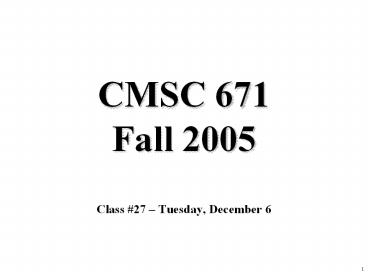CMSC 671 Fall 2005 - PowerPoint PPT Presentation
Title:
CMSC 671 Fall 2005
Description:
... (hi|D) = j P(dj|hi) P(hi) To predict the value of some unknown quantity, X (e.g., the class label for a future observation): P(X|D) = i P(X ... – PowerPoint PPT presentation
Number of Views:104
Avg rating:3.0/5.0
Title: CMSC 671 Fall 2005
1
CMSC 671Fall 2005
- Class 27 Tuesday, December 6
2
Todays class(es)
- Neural networks
- Bayesian learning
3
Bayesian Learning
- Chapter 20.1-20.2
Some material adapted from lecture notes by Lise
Getoor and Ron Parr
4
Bayesian learning Bayes rule
- Given some model space (set of hypotheses hi) and
evidence (data D) - P(hiD) ? P(Dhi) P(hi)
- We assume that observations are independent of
each other, given a model (hypothesis), so - P(hiD) ? ?j P(djhi) P(hi)
- To predict the value of some unknown quantity, X
(e.g., the class label for a future observation) - P(XD) ??i P(XD, hi) P(hiD) ?i P(Xhi)
P(hiD)
These are equal by our independence assumption
5
Bayesian learning
- We can apply Bayesian learning in three basic
ways - BMA (Bayesian Model Averaging) Dont just choose
one hypothesis instead, make predictions based
on the weighted average of all hypotheses (or
some set of best hypotheses) - MAP (Maximum A Posteriori) hypothesis Choose
the hypothesis with the highest a posteriori
probability, given the data - MLE (Maximum Likelihood Estimate) Assume that
all hypotheses are equally likely a priori then
the best hypothesis is just the one that
maximizes the likelihood (i.e., the probability
of the data given the hypothesis) - MDL (Minimum Description Length) principle Use
some encoding to model the complexity of the
hypothesis, and the fit of the data to the
hypothesis, then minimize the overall description
of hi D
6
Learning Bayesian networks
- Given training set
- Find B that best matches D
- model selection
- parameter estimation
Inducer
Data D
7
Parameter estimation
- Assume known structure
- Goal estimate BN parameters q
- entries in local probability models, P(X
Parents(X)) - A parameterization q is good if it is likely to
generate the observed data - Maximum Likelihood Estimation (MLE) Principle
Choose q so as to maximize L
i.i.d. samples
8
Parameter estimation II
- The likelihood decomposes according to the
structure of the network - ? we get a separate estimation task for each
parameter - The MLE (maximum likelihood estimate) solution
- for each value x of a node X
- and each instantiation u of Parents(X)
- Just need to collect the counts for every
combination of parents and children observed in
the data - MLE is equivalent to an assumption of a uniform
prior over parameter values
sufficient statistics
9
Sufficient statistics Example
Moon-phase
- Why are the counts sufficient?
Light-level
Earthquake
Burglary
Alarm
?A E, B N(A, E, B) / N(E, B)
10
Model selection
- Goal Select the best network structure, given
the data - Input
- Training data
- Scoring function
- Output
- A network that maximizes the score
11
Structure selection Scoring
- Bayesian prior over parameters and structure
- get balance between model complexity and fit to
data as a byproduct - Score (GD) log P(GD) ? log P(DG) P(G)
- Marginal likelihood just comes from our parameter
estimates - Prior on structure can be any measure we want
typically a function of the network complexity
Marginal likelihood
Prior
12
Heuristic search
13
Exploiting decomposability
14
Variations on a theme
- Known structure, fully observable only need to
do parameter estimation - Unknown structure, fully observable do heuristic
search through structure space, then parameter
estimation - Known structure, missing values use expectation
maximization (EM) to estimate parameters - Known structure, hidden variables apply adaptive
probabilistic network (APN) techniques - Unknown structure, hidden variables too hard to
solve!
15
Handling missing data
- Suppose that in some cases, we observe
earthquake, alarm, light-level, and moon-phase,
but not burglary - Should we throw that data away??
- Idea Guess the missing valuesbased on the other
data
Moon-phase
Light-level
Earthquake
Burglary
Alarm
16
EM (expectation maximization)
- Guess probabilities for nodes with missing values
(e.g., based on other observations) - Compute the probability distribution over the
missing values, given our guess - Update the probabilities based on the guessed
values - Repeat until convergence
17
EM example
- Suppose we have observed Earthquake and Alarm but
not Burglary for an observation on November 27 - We estimate the CPTs based on the rest of the
data - We then estimate P(Burglary) for November 27 from
those CPTs - Now we recompute the CPTs as if that estimated
value had been observed - Repeat until convergence!
Earthquake
Burglary
Alarm































